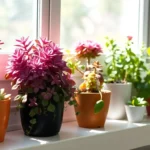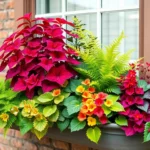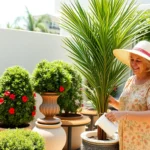We’ve all walked into a living room and felt something was missing – that spark of life that transforms a space from ordinary to extraordinary. Indoor plants aren’t just decorative elements; they’re living companions that breathe vitality into our most cherished gathering spaces while purifying the air we share with family and friends.
The right living room plants can completely revolutionize your home’s atmosphere. Whether you’re dealing with low light conditions, limited floor space, or simply want to create a stunning focal point, there’s a perfect green solution waiting to elevate your interior design game.
From dramatic floor plants that command attention to delicate trailing varieties that add subtle elegance, we’ll guide you through choosing, placing, and caring for plants that’ll make your living room the envy of every guest. Get ready to discover how the right greenery can transform your space into a thriving indoor oasis.
Choose Low-Light Indoor Plants for Living Room Success
Most living rooms don’t receive abundant natural light, making low-light plants our best allies for indoor greenery success.
Snake Plants Thrive in Dim Corners
Snake plants excel in low-light conditions while maintaining their striking vertical appearance. These architectural beauties feature thick, upright leaves with yellow edges that create visual interest even in shadowy corners. We’ve found they tolerate neglect exceptionally well, requiring water only every 2-3 weeks during growing season.
Their air-purifying qualities make them ideal for living spaces, as NASA studies show they remove formaldehyde and benzene from indoor air. Snake plants grow slowly, reaching 2-4 feet tall, which makes them perfect for floor placement beside sofas or in unused corners. They’re virtually indestructible and can survive in fluorescent lighting or rooms with only north-facing windows.
ZZ Plants Require Minimal Maintenance
ZZ plants demand almost no attention while delivering glossy, dark green foliage that elevates any living room aesthetic. These drought-tolerant champions store water in their thick stems and roots, allowing them to survive up to 6 weeks without watering. We recommend placing them in areas that receive indirect light, though they’ll adapt to almost any lighting condition.
Their waxy leaves naturally repel dust, keeping them looking pristine with minimal cleaning effort. ZZ plants grow 2-3 feet tall and wide, making them excellent choices for coffee table displays or floor planters. They’re also non-toxic to pets, though we still suggest keeping them out of reach of curious animals.
Pothos Vines Add Cascading Beauty
Pothos vines create stunning cascading displays that soften harsh furniture lines and add organic movement to living rooms. These fast-growing trailing plants feature heart-shaped leaves in various patterns, from solid green to variegated golden varieties. We love how they adapt to different light levels, though they’ll show more vibrant coloring in brighter indirect light.
Their versatility allows for multiple display options: hanging baskets, high shelves, or trained up moss poles for vertical interest. Pothos plants purify air by removing common household toxins like formaldehyde and xylene. They propagate easily in water, letting us create new plants from cuttings to expand our collection or share with friends.
Position Plants Near Natural Light Sources
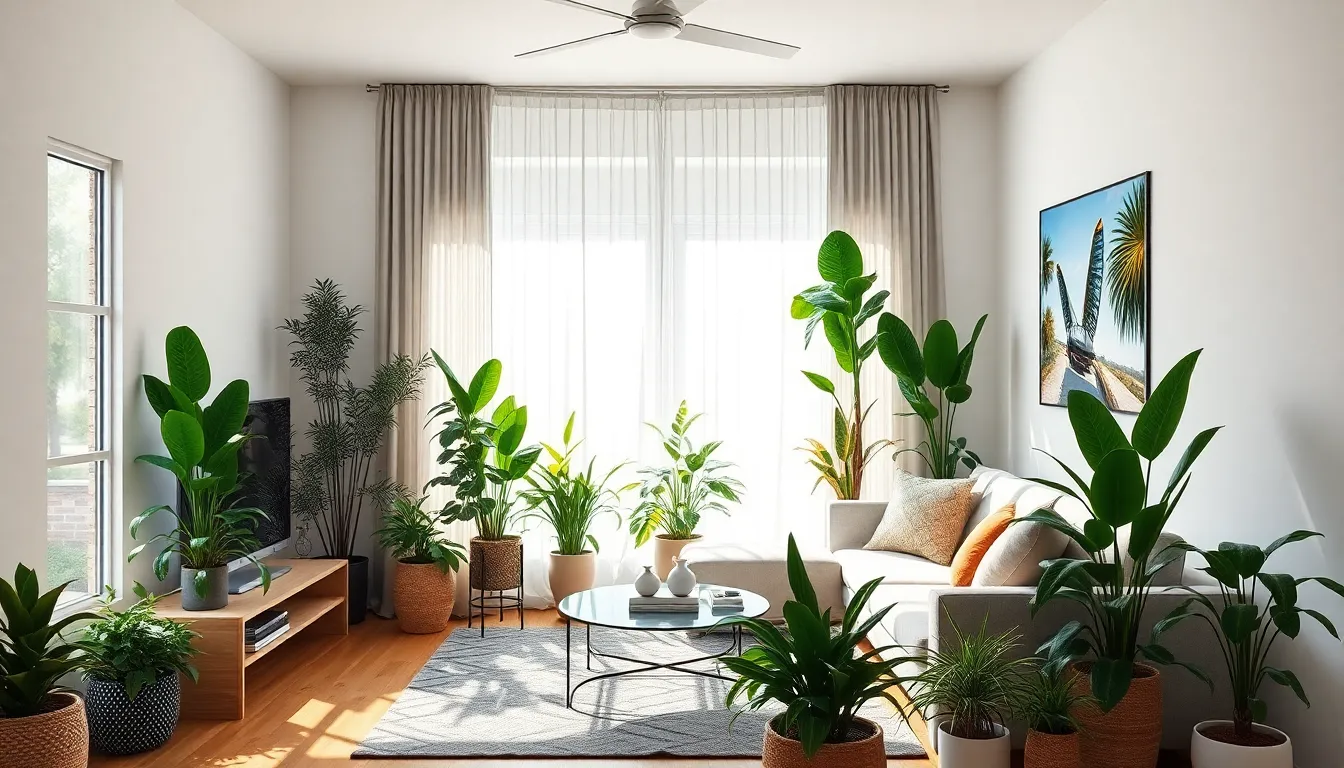
Natural light serves as the foundation for healthy indoor plant growth in our living rooms. We need to strategically place plants where they can access adequate illumination while protecting them from potential damage.
Window Placement Maximizes Sunlight Exposure
Positioning plants close to windows dramatically increases their light intake since proximity to glass surfaces determines photosynthesis success. We should place high-light plants like succulents directly in unshaded windows where they’ll receive direct sunlight throughout the day. Medium-light plants such as pothos perform best when positioned near windows with bright but indirect illumination, often filtered through curtains or blinds. Low-light plants can tolerate areas farther from windows but still benefit significantly from being within range of natural light sources.
| Plant Type | Light Requirement | Optimal Window Distance |
|---|---|---|
| High-light (succulents) | Direct sunlight | Directly at window |
| Medium-light (pothos) | Bright, indirect light | Near window with filter |
| Low-light (snake plants) | Minimal natural light | Within room’s natural light range |
Avoid Direct Harsh Afternoon Sun
Direct afternoon sunlight through south or west-facing windows can scorch leaves and dehydrate plants rapidly. We must protect our living room plants from intense midday and afternoon rays that cause leaf burn and stress. Morning sunlight provides gentler illumination that energizes plants without overwhelming them. Diffusing harsh light through sheer curtains or positioning plants slightly away from west-facing windows prevents heat damage while maintaining adequate brightness levels.
Rotate Plants Weekly for Even Growth
Weekly rotation prevents plants from developing lopsided growth patterns as they naturally lean toward their primary light source. We should turn each plant a quarter turn every seven days to ensure all sides receive equal light exposure. This practice promotes uniform photosynthesis across the entire plant structure, maintaining balanced foliage development. Regular rotation also prevents stems from becoming permanently bent toward windows, keeping our living room plants looking full and symmetrical from every angle.
Select Plants That Complement Your Living Room Decor
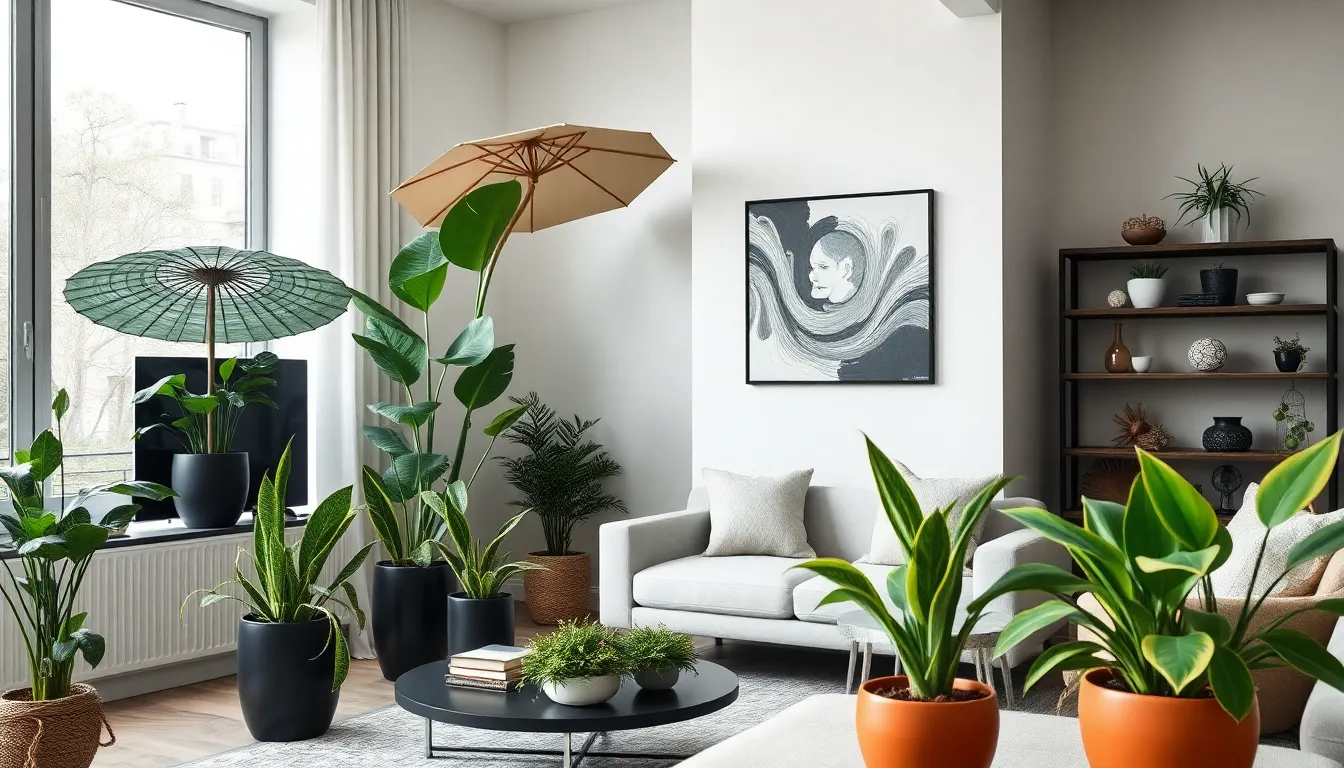
Building on strategic placement principles, we need to consider how our chosen plants will harmonize with our existing decor elements. The right plants should enhance our living room’s aesthetic while creating visual cohesion throughout the space.
Match Plant Pot Colors to Existing Color Scheme
Neutral pots work in most color schemes and provide versatility as we change seasonal decor. Bold pots can accentuate exact color motifs already present in our furniture or artwork. We should select pot colors that either blend seamlessly with our room’s palette or create intentional contrast that enhances the overall design.
Consider pots in shades that match or complement our wall colors to create visual harmony between plants and decor. Terra cotta pots suit warm, earthy color schemes, while sleek black or white containers work well with modern minimalist palettes. Metallic finishes like copper or brass can tie into existing hardware and lighting fixtures throughout our living room.
Consider Plant Size and Scale with Furniture
Large floor plants like the Umbrella Plant or Areca Palm can fill empty corners without overpowering smaller seating areas. These substantial plants create focal points while maintaining proper proportion with our existing furniture pieces. We should avoid placing oversized plants near delicate side tables or compact seating arrangements.
Compact plants suit shelves, side tables, or window ledges perfectly, providing greenery without crowding the room. Trailing varieties like String of Pearls work beautifully on floating shelves or plant stands, adding vertical interest without consuming floor space. We can use multiple smaller plants to create layered displays that complement rather than compete with our furniture’s scale.
Choose Architectural Plants for Modern Spaces
Architectural plants have structural forms that perfectly complement modern interior design principles. Dragon Tree stands out as a classic example, valued for its tall, narrow shape and colorful leaf edges that create striking vertical lines. Snake Plants also excel in modern spaces with their upright, sword-like leaves that emphasize clean, minimalist aesthetics.
These plants work exceptionally well in contemporary living rooms because they mirror the geometric forms and uncluttered lines favored in modern design. We can position architectural plants as living sculptures that enhance our space’s sophisticated atmosphere while maintaining the streamlined look that defines modern decor.
Create Visual Interest with Varying Plant Heights
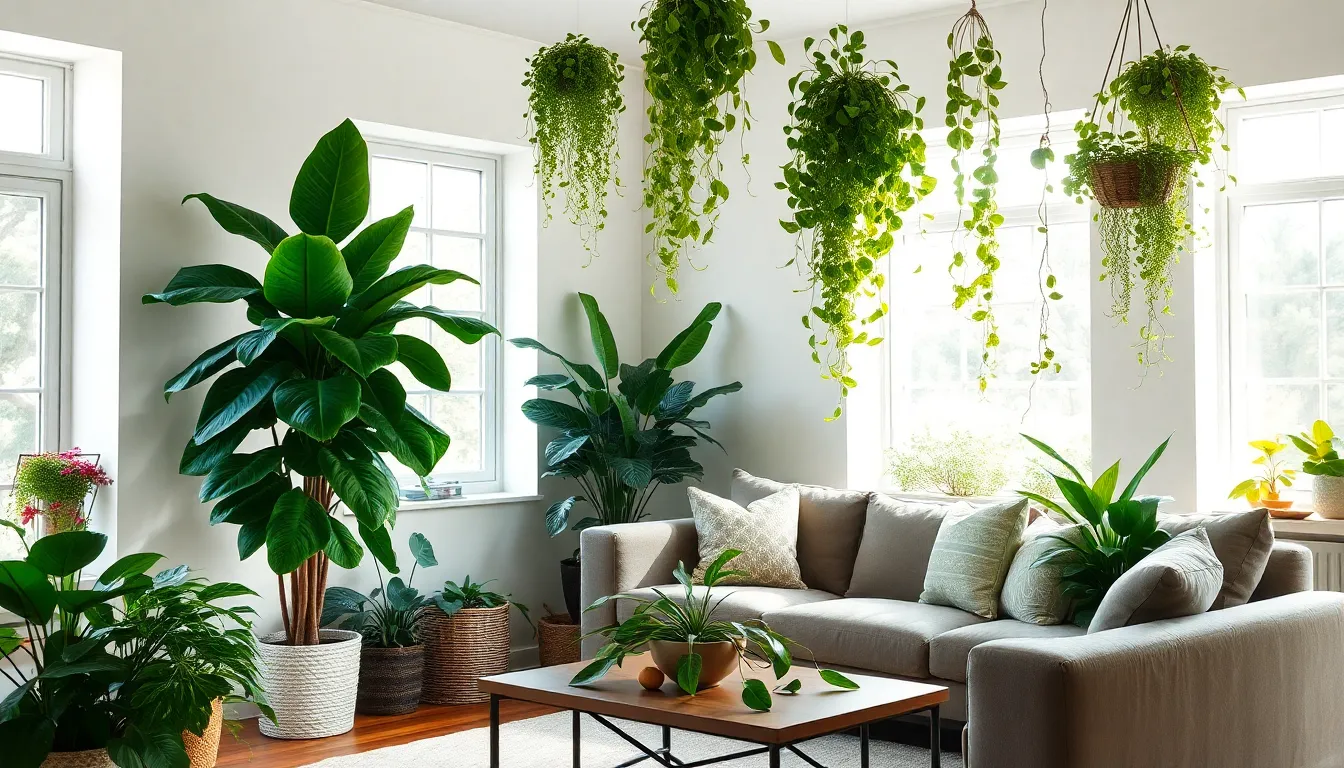
Layering plants at different heights transforms our living room into a ever-changing indoor garden that captivates the eye. We can achieve this stunning effect by mixing tall floor plants with medium-height specimens and smaller tabletop varieties.
Use Floor Plants as Statement Pieces
Floor plants serve as the foundation of our vertical plant display strategy. Large-leafed species like Monstera or Rubber Plants create bold focal points that anchor the entire room’s design. We position these dramatic specimens near seating areas or entryways where they’ll make the strongest visual impact.
Tall plants such as Fiddle Leaf Fig or Dragon Tree bring essential height and structure to empty corners. These towering beauties draw the eye upward and create a sense of grandeur in our living space. We place them strategically beside furniture pieces to balance the room’s proportions and add natural architecture.
The positioning of floor plants enhances our room’s energy while providing striking statement pieces. Bold foliage patterns and impressive size make these plants conversation starters that guests notice immediately. We choose specimens with distinct leaf shapes and textures to maximize their decorative impact.
Add Tabletop Plants for Mid-Level Greenery
Tabletop plants fill the crucial middle layer of our vertical plant arrangement. Smaller plants placed on tables, shelves, or mantels provide greenery right at eye level where we appreciate their details most. Plants like Anthurium or Pothos thrive in these elevated positions and bring vibrant color to this important height range.
Mid-level placement creates visual bridges between our floor plants and any hanging specimens above. We select compact varieties with interesting foliage patterns or colorful blooms that complement our larger plants below. These medium-height additions prevent visual gaps and create a cohesive layered look.
Strategic placement on different surfaces throughout the room distributes greenery evenly across our living space. We use varying table heights and shelf levels to stagger our plants at multiple elevations. This approach creates depth and ensures every sight line includes some natural beauty.
Incorporate Hanging Plants for Vertical Drama
Hanging plants maximize our vertical space while adding natural drama overhead. Trailing varieties such as Pothos or certain ferns introduce softness and graceful movement to our room’s upper regions. We hang these cascading beauties near windows or from ceiling hooks to create lush canopy effects.
Suspended plants draw attention upward and make our ceilings appear higher than they actually are. We choose trailing species that cascade elegantly downward to soften hard architectural lines. These overhead additions create intimate nooks beneath their flowing foliage.
Ceiling-mounted plants use space that would otherwise remain empty and unused. We position hanging planters at varying heights to avoid creating a uniform, static display. This strategic vertical placement adds the final layer to our multi-dimensional indoor garden design.
Group Plants Together for Maximum Impact
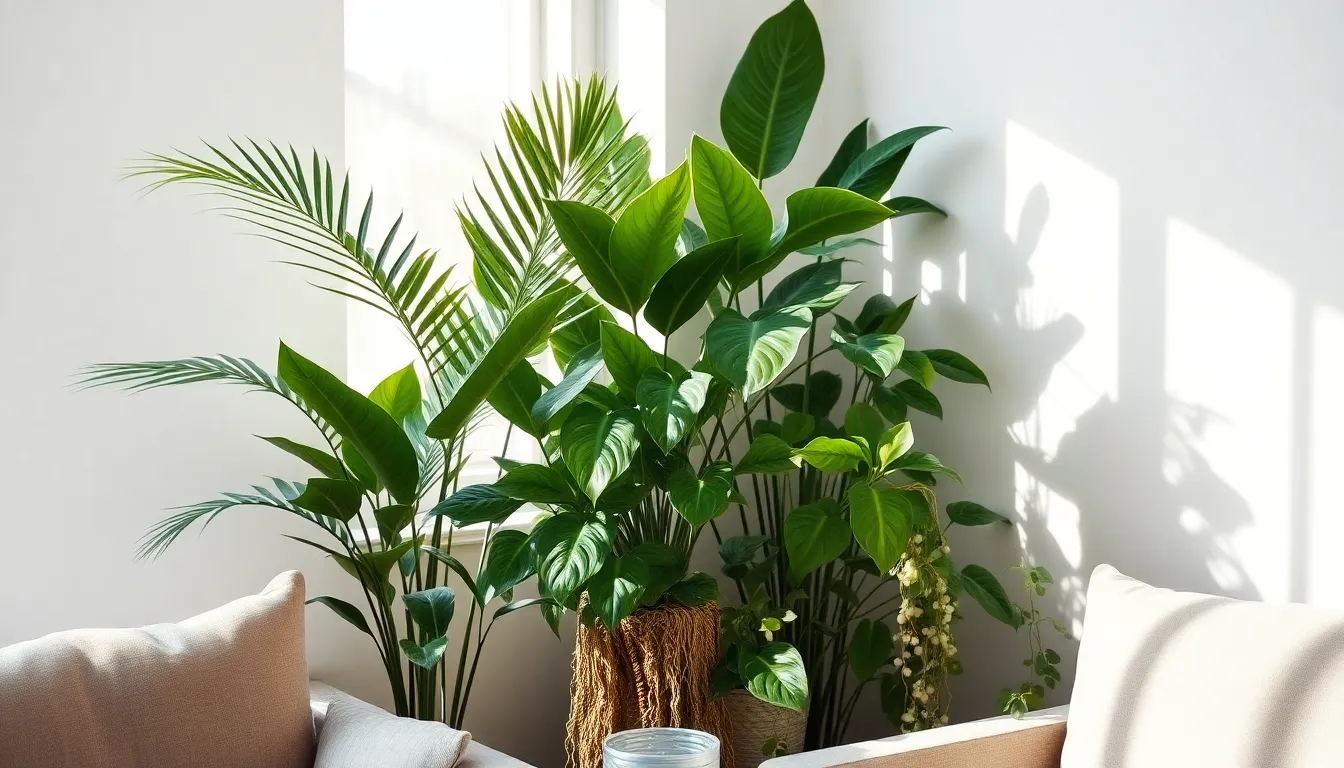
Grouping plants strategically transforms scattered greenery into stunning visual displays that command attention and create cohesive design statements.
Create Plant Clusters in Empty Corners
Empty corners become ever-changing focal points when we fill them with thoughtfully arranged plant clusters. Large plants like Areca palms, Kentia palms, or Fiddle Leaf Figs work exceptionally well in these spaces, serving as natural anchors that draw the eye upward and outward.
Position these statement plants at least 3 feet below the ceiling to ensure proper growth space and visual balance. Rubber trees and birds of paradise add impressive vertical interest while filling unused corner areas without overwhelming the surrounding furniture.
Corner clusters work best when we avoid crowding them with nearby furniture pieces. This spacing allows each plant to showcase its natural form while creating breathing room that enhances the overall arrangement’s impact.
Mix Different Textures and Leaf Shapes
Combining diverse leaf textures and shapes creates ever-changing arrangements that feel naturally organic rather than artificially staged. Delicate trailing plants like String of Pearls pair beautifully with broad leafed specimens such as Monsteras or birds of paradise, establishing visual contrast that keeps arrangements captivating.
Varying textures prevents plants from blending together into a monotonous green mass. Smooth, glossy leaves complement rough, textured foliage while creating depth and dimension throughout our living spaces.
Mixing different leaf sizes adds another layer of visual interest to plant groupings. Large, architectural leaves provide bold statements while smaller, intricate foliage fills gaps and adds delicate details that complete the overall composition.
Maintain Odd Numbers for Natural Arrangements
Following the rule of three creates plant groupings that appear intentional yet naturally organic rather than formally staged. Odd numbered clusters, particularly groups of three or five plants, establish visual harmony while avoiding the stiffness that even numbered arrangements often produce.
This principle applies equally to small tabletop displays and larger floor based plant clusters. Three succulents grouped on a coffee table create the same pleasing aesthetic as five varied plants arranged in a corner setting.
Odd numbered groupings work because they allow our eyes to move naturally through the arrangement without getting trapped in symmetrical patterns. The result is plant displays that feel effortlessly beautiful while maintaining sophisticated visual appeal throughout our living rooms.
Maintain Proper Watering and Care Routines
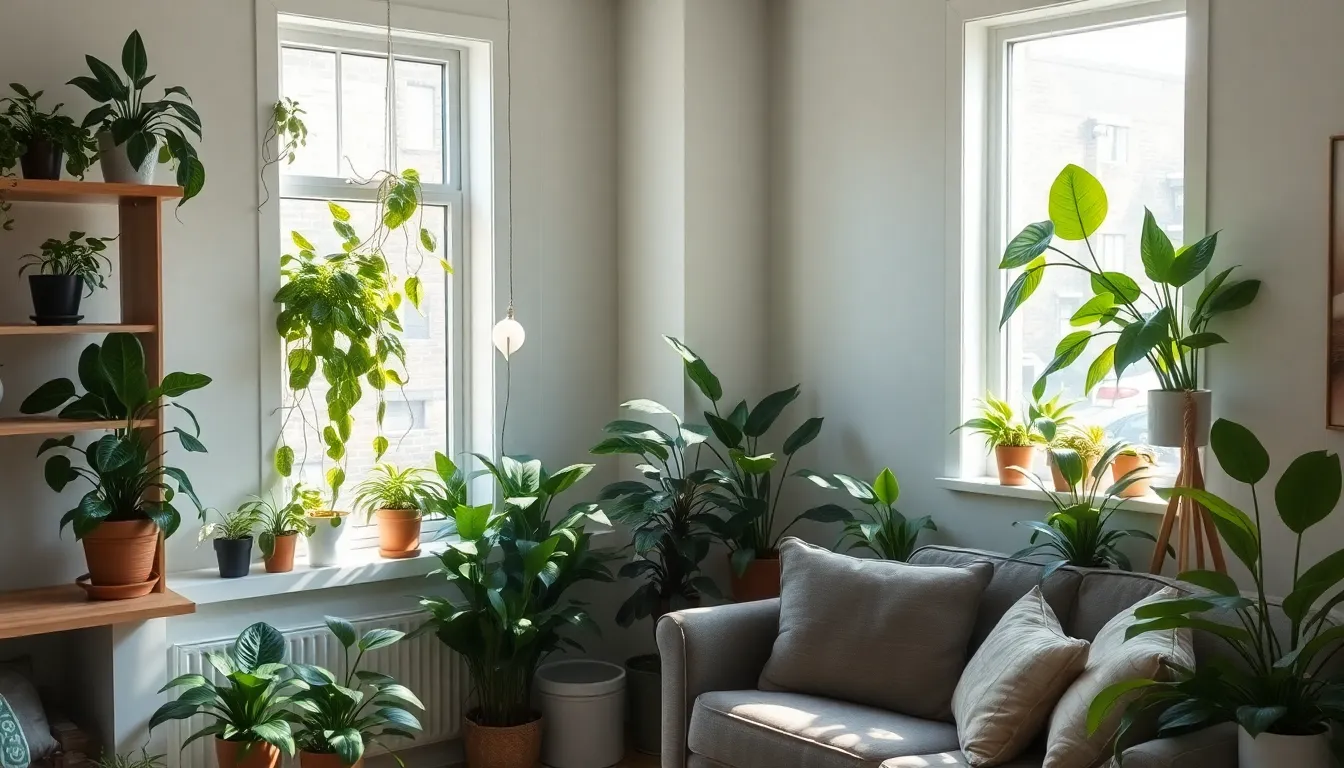
We’ve established our beautiful living room plant display, but keeping these green companions thriving requires consistent care and attention to their individual needs.
Establish Weekly Watering Schedules
Different plant varieties demand unique watering frequencies based on their natural growing conditions. Snake plants need water every 2-4 weeks since they’re desert natives that store moisture in their thick leaves. Aloe and other succulents require watering every 2 weeks to prevent root rot from excess moisture. Pothos and fiddle leaf figs thrive with water every 10-14 days, striking a balance between their tropical origins and indoor growing conditions.
Desert plants like succulents and snake plants should have completely dry soil between waterings to mimic their natural habitat. Most other indoor plants need water when the top inch of soil feels dry to the touch. Creating a weekly schedule helps us track each plant’s needs and prevents the common mistake of overwatering our living room greenery.
Monitor Soil Moisture Levels Regularly
Regular soil checks prevent the two most common plant problems we encounter in our living rooms. Touching the soil surface or using a moisture meter gives us accurate readings of each plant’s hydration needs. Overwatering causes yellow leaves as roots struggle in waterlogged conditions, while underwatering creates crispy brown leaf edges that indicate stress.
Peace lilies demonstrate how exact moisture preferences affect plant health since they thrive in consistently moist but never waterlogged soil. Establishing this monitoring routine takes just minutes each week but saves our plants from the stress of improper watering. Different species show moisture stress in unique ways, so learning each plant’s warning signs helps us respond quickly to their needs.
Adjust Care Based on Seasonal Changes
Seasonal shifts dramatically affect our indoor plants’ water requirements throughout the year. Warmer months increase evaporation rates and plant growth, requiring more frequent watering as our living room plants actively photosynthesize and transpire. Cooler months or lower light conditions call for reduced watering frequency to prevent root rot in slower growing plants.
Lighting adjustments complement our seasonal watering changes since plants like succulents need bright light year round while aglaonema and aspidistra tolerate low light conditions with minimal water. Winter heating systems can dry out our living room air, affecting how quickly soil moisture evaporates. Spring growth spurts may require temporary increases in both water and nutrients as our plants emerge from their winter dormancy period.
Address Common Living Room Plant Challenges
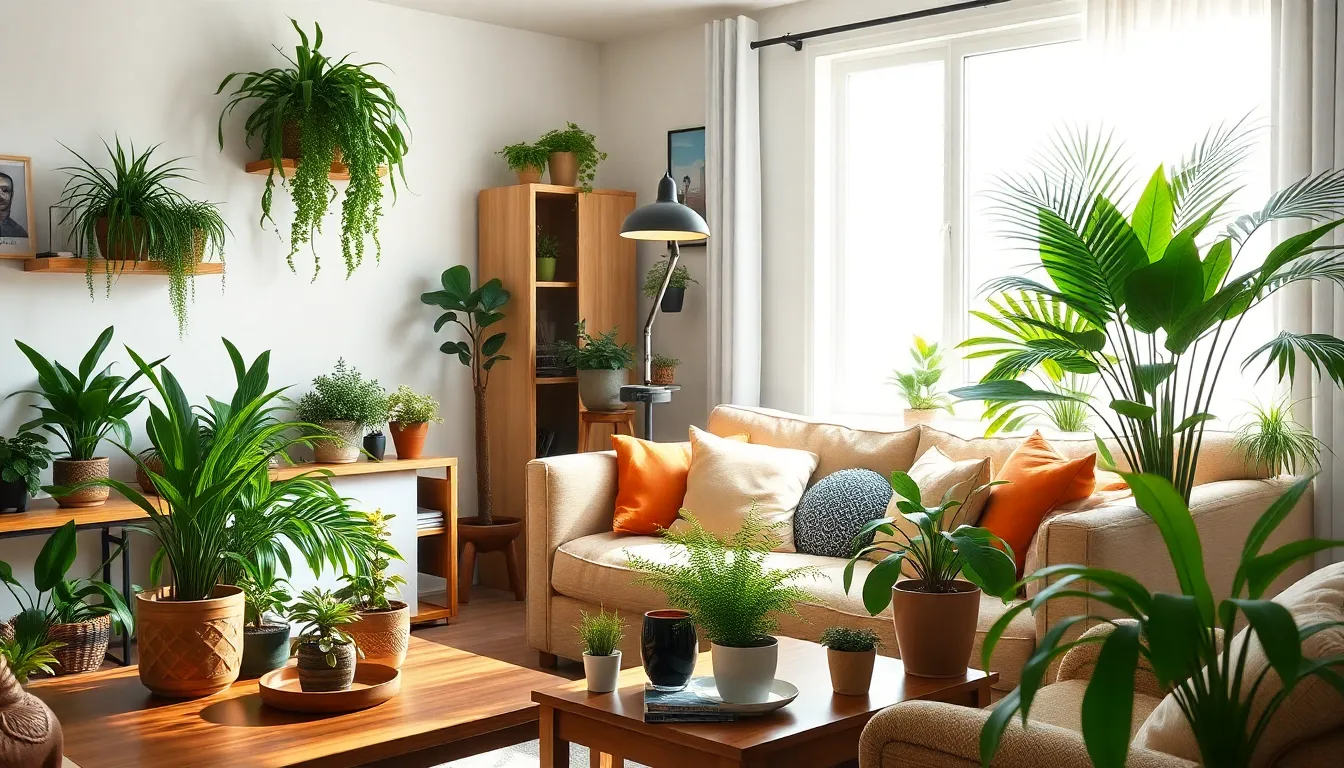
Even with proper placement and care routines established, we’ll encounter exact challenges that can affect our indoor plant success. These common issues have practical answers that’ll help us maintain thriving greenery in our living spaces.
Combat Dry Indoor Air with Humidity Answers
Indoor plants naturally regulate humidity by absorbing and releasing moisture throughout the day. They act like living humidifiers and dehumidifiers, maintaining balanced indoor environments that improve air quality. This natural process reduces dryness related issues such as dry skin, respiratory discomfort, and static electricity buildup.
We can boost humidity levels around our plants by grouping them together, creating microenvironments where moisture accumulates. Placing water filled pebble trays beneath plant containers adds extra humidity as water evaporates upward. Misting plants weekly with distilled water provides additional moisture, though we should avoid misting fuzzy leaved varieties like African violets that can develop water spots.
Manage Pet Safety with Non-Toxic Plant Choices
Pet friendly plants protect our furry family members while maintaining beautiful living room greenery. Many popular houseplants like pothos and peace lilies can be toxic if ingested by cats or dogs, making careful plant selection crucial for pet owning households.
Spider plants offer cascading beauty with zero toxicity concerns, thriving in various light conditions while producing adorable plantlets. Boston ferns create lush texture without posing risks to curious pets who might nibble on fronds. Parlor palms add tropical elegance while remaining completely safe for both cats and dogs.
We should research each plant’s toxicity level before bringing it home, keeping potentially harmful varieties in hanging planters or elevated locations away from pet access.
Handle Low Light with Grow Light Supplements
Grow lights provide the light spectrum plants need for photosynthesis when natural light falls short. These artificial lighting answers enable low light tolerant plants to thrive even in dim living room corners or basement spaces.
LED grow lights offer energy efficient options that produce minimal heat while delivering targeted light wavelengths. We can position these lights 12 to 24 inches above plants, running them for 6 to 12 hours daily depending on plant requirements. Full spectrum bulbs work best for most houseplants, providing both blue light for foliage growth and red light for flowering.
Timer controlled grow lights ensure consistent lighting schedules without daily monitoring, automatically adjusting to our plants’ needs throughout different seasons.
Conclusion
Transforming your living room with indoor plants doesn’t have to be complicated. We’ve shown you how the right combination of placement lighting and care can turn any space into a thriving green oasis that purifies your air and enhances your home’s aesthetic.
Whether you’re working with bright windows or dimly lit corners there’s a perfect plant waiting to flourish in your living room. From dramatic floor plants that make bold statements to delicate trailing varieties that add soft elegance you now have the knowledge to create arrangements that reflect your personal style.
Remember that successful indoor gardening is about understanding each plant’s unique needs and creating consistent care routines. With proper watering schedules strategic positioning and attention to seasonal changes your living room plants will reward you with years of natural beauty and improved indoor air quality.
Frequently Asked Questions
What are the best low-light indoor plants for living rooms?
Snake plants, ZZ plants, and Pothos are excellent choices for low-light living rooms. Snake plants offer striking vertical appearance and air-purifying qualities while thriving in dim corners. ZZ plants feature glossy foliage and require minimal maintenance. Pothos vines provide cascading beauty and adapt well to various light conditions, making them versatile for different display options.
How should I position plants to maximize natural light exposure?
Place high-light plants like succulents directly at windows, medium-light plants like Pothos near filtered light, and low-light plants like snake plants within the room’s natural light range. Avoid direct harsh afternoon sun by using sheer curtains or positioning plants away from intense rays. Rotate plants weekly to promote even growth and prevent lopsidedness.
How can I choose plants that match my living room decor?
Match pot colors to your room’s color scheme – neutral pots provide versatility while bold pots accent specific themes. Consider plant size relative to furniture: use large floor plants for empty corners and compact plants for shelves. Architectural plants like Dragon Trees complement modern interiors, serving as living sculptures that enhance sophisticated atmospheres.
What’s the best way to create visual interest with different plant heights?
Mix tall floor plants, medium-height specimens, and smaller tabletop varieties for dynamic displays. Use large-leafed species like Monstera as bold focal points, tall plants like Fiddle Leaf Figs for corner structure, and tabletop plants like Anthurium for mid-level greenery. Add hanging plants to maximize vertical space and create dramatic overhead effects.
How should I group plants together for maximum impact?
Create plant clusters in empty corners using large plants like Areca palms, positioning them at least 3 feet below the ceiling. Mix different textures and leaf shapes for organic arrangements. Use odd-numbered groupings to maintain visual harmony and avoid stiffness. This approach transforms scattered greenery into cohesive design statements.
What are the proper watering schedules for common indoor plants?
Establish weekly schedules based on each plant’s needs: snake plants need water every 2-4 weeks, while Pothos and fiddle leaf figs thrive with watering every 10-14 days. Monitor soil moisture regularly to prevent over or under-watering. Adjust frequency seasonally – increase in warmer months, reduce in cooler months to prevent root rot.
How can I address common indoor plant challenges?
Combat dry air by grouping plants together and using pebble trays to boost humidity. Choose non-toxic plants like spider plants and Boston ferns if you have pets. Use grow lights to supplement natural light in dim spaces. Regular monitoring and adjusting care routines based on seasonal changes ensures healthy plant growth year-round.


